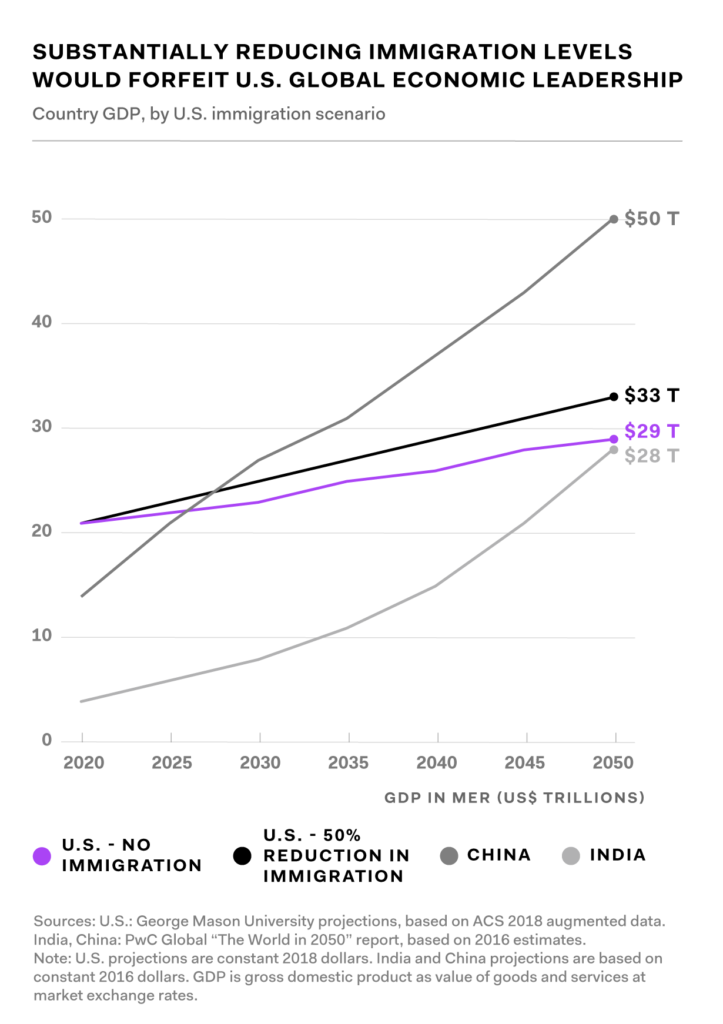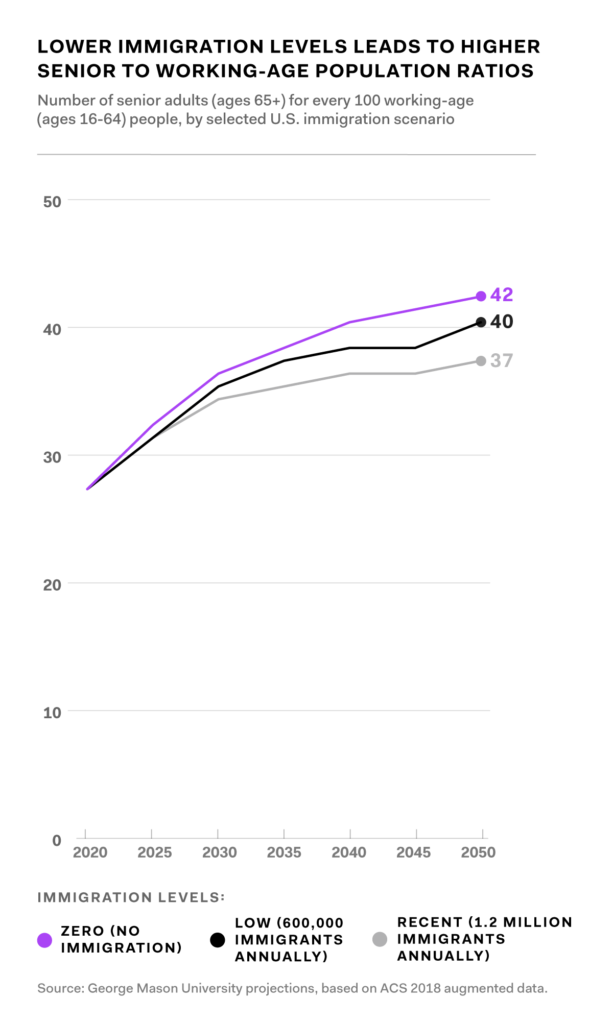Immigration has long been the great American competitive advantage, helping fuel growth and innovation that has kept the United States the global economic leader for decades. However, recent debates in Congress about how to improve the U.S. immigration system have been undermined by restrictionist opposition to any increase in immigration levels. Instead, restrictionists have pushed to reduce lawful immigration, at the expense of American prosperity.
Reducing immigration
means a smaller, poorer, and weaker America


“Significantly reducing immigration would cost the U.S. its role as the leading global economy”
The U.S. immigration system needs reform. Immigration levels have not been updated in 30 years, and U.S. immigration levels as a share of our economy or population lag behind those of other advanced countries. The economy is not zero-sum, with one person’s success taking away from another’s; research shows that increasing immigration creates jobs, raises wages, and improves the lives of native-born Americans.

In fact, significantly reducing immigration would cost the U.S. its role as the leading global economy in the long term, potentially falling to third place behind China and India after 2050. In the short term, if immigration continued to be restricted at the near-zero levels seen in 2020 during the pandemic, it is projected that the American and Chinese economies would be about the same size in 2025, and China’s economy would exceed the U.S. economy by several trillion come 2030. The projections are clear: the U.S. needs to welcome more immigrants to continue growing the economy and expanding the workforce. Failing to do so—or worse, reducing immigration even further—would be a tremendous drag on the economy, sacrificing trillions in potential economic growth.
“The U.S. faces a serious demographic challenge as the population ages, and the ratio of seniors to working-age people continues to increase”
Reducing immigration would cost the United States its global economic leadership by sacrificing a critical tool that immigration offers: boosting population through workforce growth. The U.S. faces a serious demographic challenge as the population ages, and the ratio of seniors to working-age people continues to increase. And, as fertility rates continue to fall, U.S. population growth is slowing. Without increasing population growth, the workforce will not be able to sustain economic growth and support critical, and popular, fiscal programs like Social Security.

The U.S. population is aging, and it’s doing so quickly. According to the U.S. Census Bureau, the senior population has increased significantly in recent years as Baby Boomers are aging. The 65-and-older population grew by a third from 2010 to 2019, while the under-18 population actually shrank. This means more people are drawing on support programs like Social Security, and fewer people are available to enter the workforce and replenish them.
Increased immigration can counter these trends. In the short -term, immigrants tend to be younger, reducing the senior-to-worker ratio. They have relatively higher levels of employment, increasing contributions to critical programs. In the long term, immigrants will have families of their own, boosting the population overall, as well as the future workforce.
“Further restricting immigration will only accelerate the decline, leaving Social Security funds depleted before 2034”
On the other hand, further reducing immigration will only accelerate the decline, leaving Social Security funds depleted before 2034, the year the Social Security Administration projects the trust fund will be at zero with recent immigration levels. The numbers don’t lie: lowering U.S. immigration levels shrinks the working-age population needed to grow the economy. As other countries grow their populations, the U.S. will fall further behind.
The costs of immigration restriction are not hypothetical; the last few years have been a perfect case study, as the Trump Administration took hundreds of actions to restrict the immigration process, and ultimately used the COVID-19 pandemic as an excuse to virtually shut down the immigration system. The result was jobs left unfilled or moved offshore, American families separated, and billions of dollars in lost economic growth.
“Congress must embrace immigration and expand the system to meet our needs and guarantee our economic prosperity”
Leaders in Congress must also not conflate the legalization of undocumented immigrants with increasing immigration levels. While undocumented individuals already in the U.S. may not have an immigration status, they are in the workforce already, contributing significantly and accounted for in our population projections. Legalization will not increase immigration; it will simply provide security and expanded opportunity for those already here. Meanwhile, improving and expanding lawful immigration channels will reduce incentives for unauthorized immigration while also protecting the benefits of immigration for future generations.
Why do restrictionists want a smaller, poorer, and weaker America? Why do they want to sacrifice this tremendous American competitive advantage, to cede the global stage to other countries? What solution do they offer for the serious demographic and economic challenges that lie ahead?
The true answer is that they have no fact-based solutions. But there are a number of simple and bipartisan steps Congress can take to actually increase, not decrease, immigration. No matter the path Congress takes, it must reject the proposals of immigration restrictionists that sacrifice our competitive advantage. Instead, Congress must embrace immigration and expand the system to meet our needs and guarantee our economic prosperity.
Tell the world; share this article via...
Get Involved
We need your help to move America forward. Learn what you can do.